When we had our little bakery in Bantan Munti, Bataan, Pan De Coco was always the first thing to sell out every morning. I remember mixing batch after batch of that sweet coconut filling, and the smell would drift through the whole shop, customers would walk in just following their noses!
Even though we had to close the bakery, I'm sharing this exact recipe with you because everyone deserves to taste these pillowy soft rolls filled with that perfect coconut sweetness. My Lolo Amen taught me that the secret isn't just in the ingredients, but in taking your time with each step.
Trust me, once you make these at home, you'll understand why people used to line up at our counter every single day.
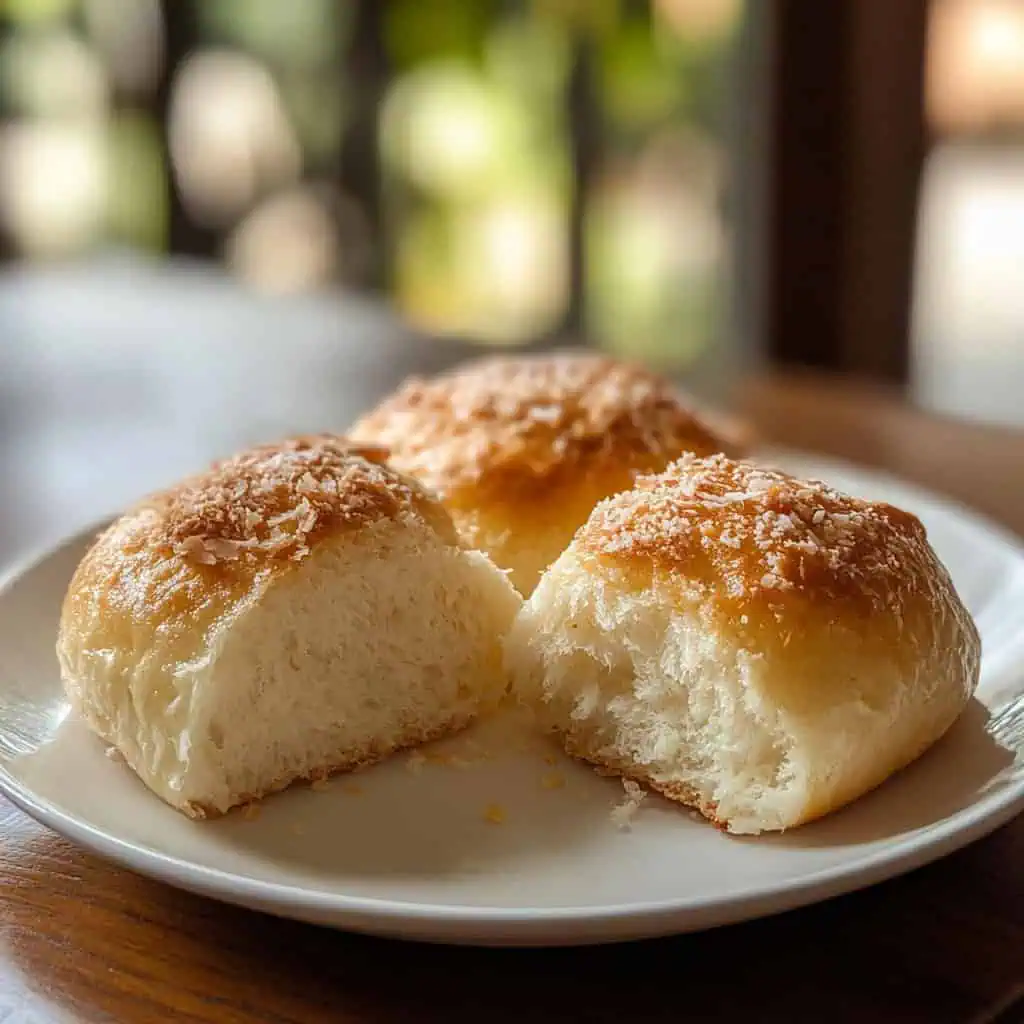
Why You'll Love This Recipe
This Pan De Coco recipe creates incredibly soft, pillowy bread rolls bursting with sweet coconut filling that melts in your mouth. These Filipino coconut bread rolls are budget-friendly yet taste like they came from your favorite bakery. The dough is surprisingly easy to work with, and the aroma filling your kitchen while they bake is absolutely divine.
Perfect for breakfast with coffee, afternoon snacks, or whenever you crave something comforting and sweet. Each bite delivers the perfect balance of fluffy bread and rich coconut goodness that will transport you straight to a Filipino bakery.
Jump to:
Ingredients
- 3 ½ cups all-purpose flour
- ¾ cup warm water
- 2 ¼ teaspoons active dry yeast
- 2 ¼ teaspoons salt
- 2 large eggs, lightly beaten
- ¼ cup soft brown sugar
- ¼ cup melted butter
- 1 cup dried coconut flakes
- 2 tablespoons butter, melted (for filling)
- 1 cup brown sugar (for filling)
- ½ teaspoon vanilla extract
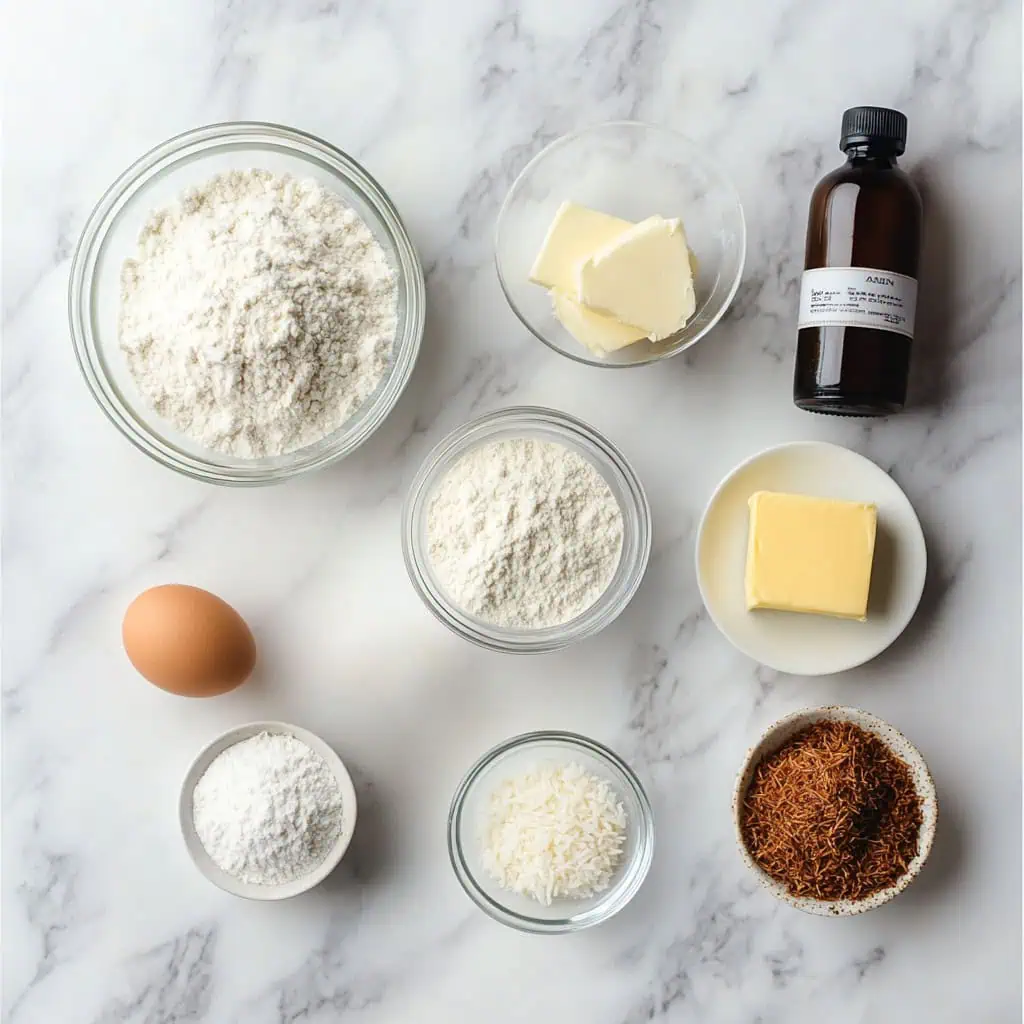
The combination of warm water and yeast creates the perfect environment for a fluffy, airy texture. Brown sugar adds depth and caramel notes that complement the coconut beautifully, while eggs provide richness and help bind everything together.
The coconut flakes and brown sugar filling creates that signature sweet, chewy center that makes Pan De Coco so irresistible.
Equipment
- Large mixing bowl - for combining and rising the dough
- Small saucepan - to cook the coconut filling to the right consistency
- Baking sheet - lined with parchment or greased for baking
- Kitchen towel or plastic wrap - to cover dough during rising
- Measuring cups and spoons - for accurate ingredient portions
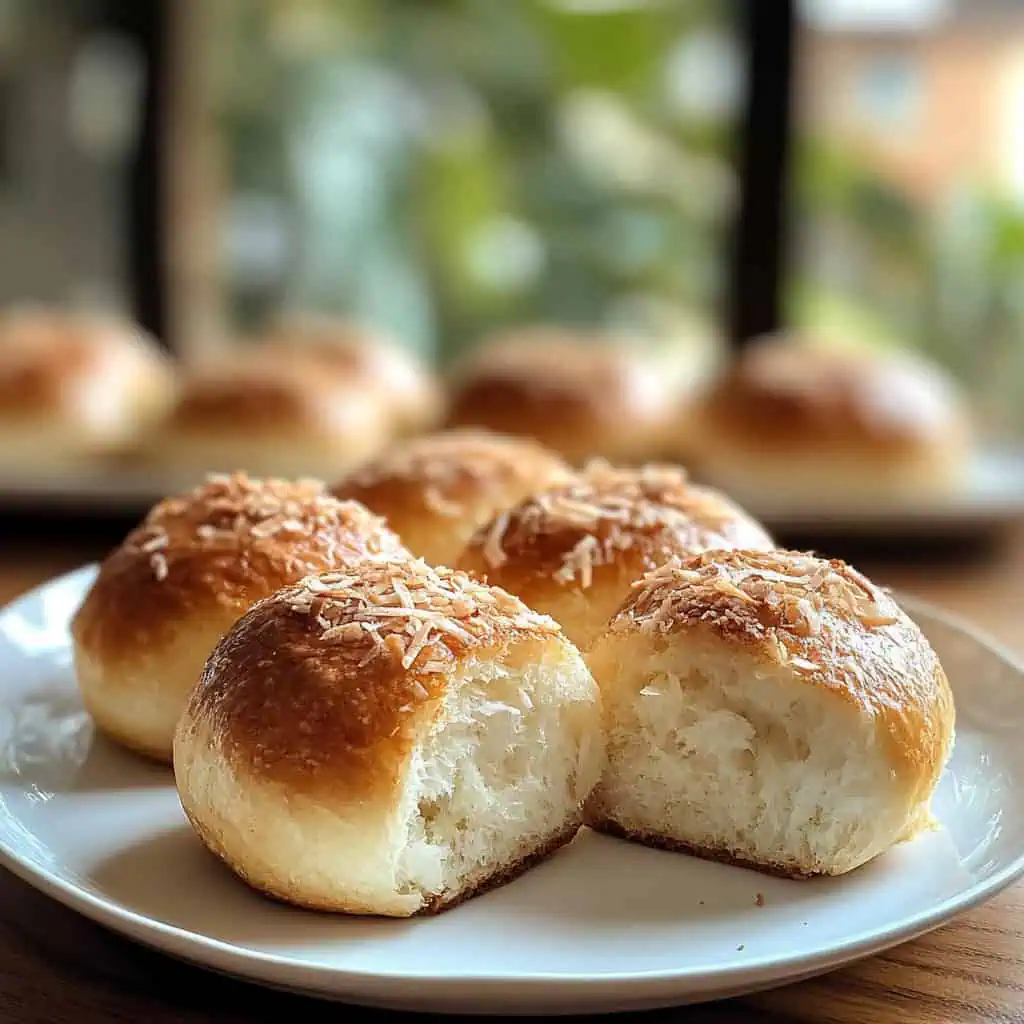
How To Make
- Combine the yeast and warm water in a large bowl, stirring briefly until well blended. Let this mixture sit for 2-3 minutes until you see bubbles forming on the surface, which means your yeast is active and ready.
- Add the beaten eggs, melted butter, and brown sugar to the yeast mixture, stirring until everything is well combined and the sugar begins to dissolve.
- Gradually add the flour and salt to the bowl, then use your hands to gently mix all ingredients until they form a cohesive dough. Don't knead at this stage - just mix until combined.
- Cover the bowl with plastic wrap or a damp kitchen towel and place in a warm spot to rise for at least 1 hour, or until the dough doubles in size.
- While the dough rises, prepare your coconut filling by combining coconut flakes, 2 tablespoons melted butter, brown sugar, and vanilla extract in a small saucepan over medium-low heat.
- Simmer the filling mixture, stirring occasionally, until the liquid reduces and the mixture becomes thick and sticky. This usually takes 8-10 minutes. Remove from heat and let it cool completely.
- Once the dough has doubled, punch it down in the center to release the air, then lightly dust with flour to prevent sticking.
- Pinch off lime-sized portions of dough and flatten each piece by hand on a lightly floured surface to create small circles about 4 inches wide.
- Place 2 tablespoons of the cooled coconut filling in the center of each flattened dough circle.
- Gather all edges of the dough up and around the filling, pinching them together at the top and twisting to seal completely. Make sure there are no gaps where filling can leak out.
- Place each filled dough ball seam-side down on a greased baking sheet, leaving about ½ inch space between each roll.
- Cover the shaped rolls and let them rise in a warm place for another 30 minutes until they're puffy and slightly larger.
- Preheat your oven to 350°F about 5 minutes before the second rise is complete.
- Bake the rolls for 15 minutes or until the tops turn golden brown and sound hollow when lightly tapped.
- Remove from oven and let the Pan De Coco rest on the baking sheet for 5 minutes before transferring to a cooling rack or serving immediately while warm.

Tips from Lola's Kitchen
- Test your yeast first - if it doesn't bubble after 5 minutes, your yeast might be dead
- Keep your water temperature around 105-110°F - too hot will kill the yeast, too cold won't activate it
- Don't overfill the rolls or they'll burst open during baking
- Seal the dough edges really well by pinching and twisting - this prevents filling from leaking
- Place a bowl of warm water in your oven (turned off) to create the perfect rising environment
- Brush tops with melted butter right after baking for extra shine and flavor
Substitutions
- Use coconut oil instead of butter for a more intense coconut flavor
- Sweetened shredded coconut works if you can't find flakes - just reduce the brown sugar slightly
- White sugar can replace brown sugar, but you'll lose some depth of flavor
- Instant yeast can substitute active dry yeast using the same amount
- Milk can replace water for a richer dough texture
Troubleshooting
- Dough not rising? Check if your yeast is fresh and water temperature wasn't too hot
- Filling leaking out? Make sure to seal edges tightly and don't overfill
- Rolls too dense? Don't skip the rising times - patience makes all the difference
- Bottom burning? Place baking sheet on middle rack and reduce temperature to 325°F
- Filling too runny? Cook it longer until it thickens, or add a tablespoon of flour
Storage & Reheating
- Store in an airtight container at room temperature for up to 3 days
- Freeze individual rolls wrapped in plastic for up to 3 months
- Reheat in 300°F oven for 5-8 minutes to restore softness
- Microwave for 15-20 seconds for quick warming, but oven method keeps texture better
- Day-old rolls are perfect toasted with butter for breakfast
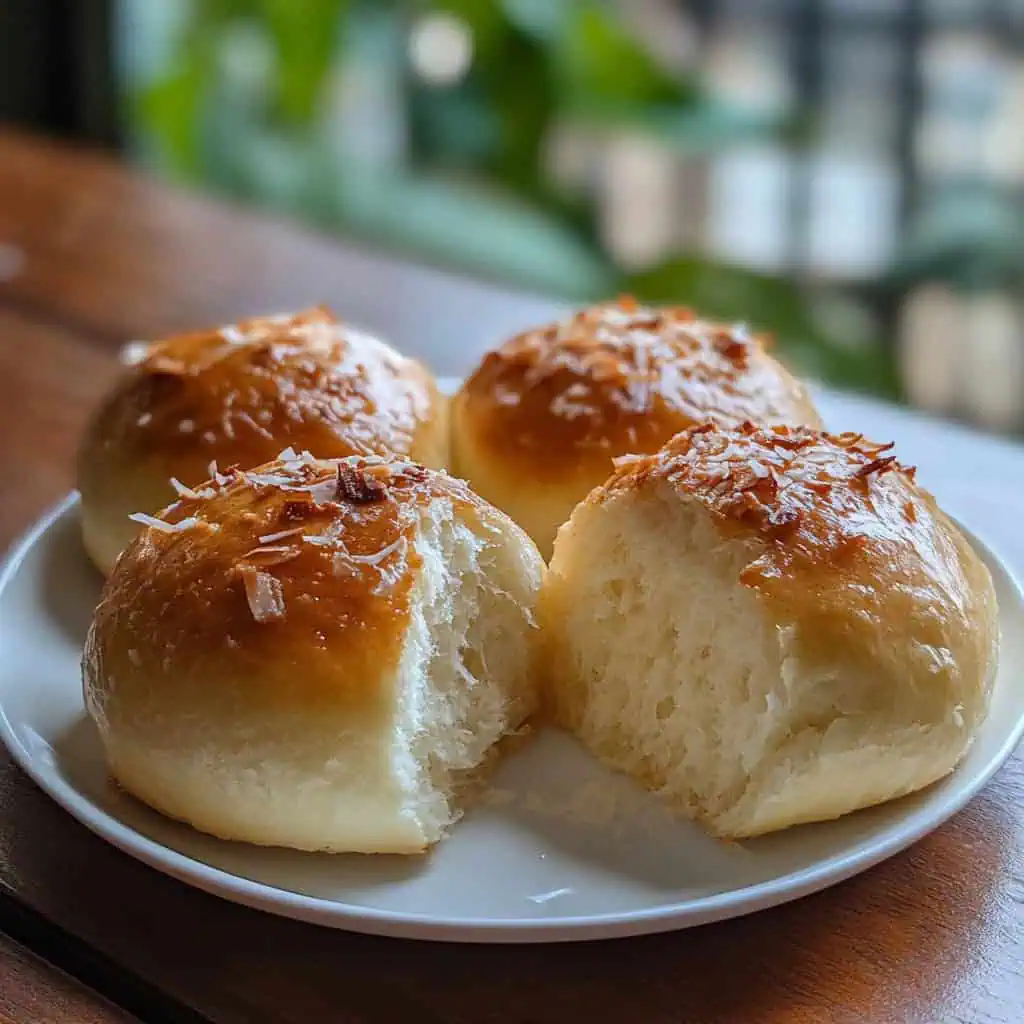
FAQ
Can I make the dough ahead?
Yes, you can refrigerate the dough after first rise for up to 24 hours
Why is my filling too sweet?
Reduce brown sugar to ¾ cup if you prefer less sweetness
Can I use fresh coconut?
Absolutely! Grate fresh coconut and cook the same way
How do I know when they're done?
They should sound hollow when tapped and be golden brown
Can I add other flavors?
Try adding a pinch of salt to the filling or some orange zest for variation
Related
Looking for other recipes like this? Try these:
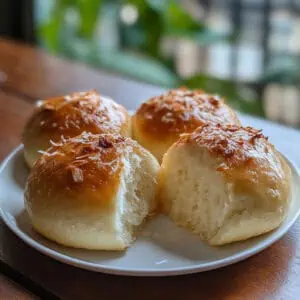
Pan De Coco (Filipino Coconut Bread Rolls)
Ingredients
- 3 ½ cups all-purpose flour
- ¾ cup warm water
- 2 ¼ teaspoons active dry yeast
- 2 ¼ teaspoons salt
- 2 large eggs lightly beaten
- ¼ cup soft brown sugar
- ¼ cup melted butter
- 1 cup dried coconut flakes
- 2 tablespoons butter melted (for filling)
- 1 cup brown sugar for filling
- ½ teaspoon vanilla extract
Instructions
- Combine the yeast and warm water in a large bowl, stirring briefly until well blended. Let this mixture sit for 2-3 minutes until you see bubbles forming on the surface, which means your yeast is active and ready.
- Add the beaten eggs, melted butter, and brown sugar to the yeast mixture, stirring until everything is well combined and the sugar begins to dissolve.
- Gradually add the flour and salt to the bowl, then use your hands to gently mix all ingredients until they form a cohesive dough. Don't knead at this stage - just mix until combined.
- Cover the bowl with plastic wrap or a damp kitchen towel and place in a warm spot to rise for at least 1 hour, or until the dough doubles in size.
- While the dough rises, prepare your coconut filling by combining coconut flakes, 2 tablespoons melted butter, brown sugar, and vanilla extract in a small saucepan over medium-low heat.
- Simmer the filling mixture, stirring occasionally, until the liquid reduces and the mixture becomes thick and sticky. This usually takes 8-10 minutes. Remove from heat and let it cool completely.
- Once the dough has doubled, punch it down in the center to release the air, then lightly dust with flour to prevent sticking.
- Pinch off lime-sized portions of dough and flatten each piece by hand on a lightly floured surface to create small circles about 4 inches wide.
- Place 2 tablespoons of the cooled coconut filling in the center of each flattened dough circle.
- Gather all edges of the dough up and around the filling, pinching them together at the top and twisting to seal completely. Make sure there are no gaps where filling can leak out.
- Place each filled dough ball seam-side down on a greased baking sheet, leaving about ½ inch space between each roll.
- Cover the shaped rolls and let them rise in a warm place for another 30 minutes until they're puffy and slightly larger.
- Preheat your oven to 350°F about 5 minutes before the second rise is complete.
- Bake the rolls for 15 minutes or until the tops turn golden brown and sound hollow when lightly tapped.
- Remove from oven and let the Pan De Coco rest on the baking sheet for 5 minutes before transferring to a cooling rack or serving immediately while warm.
Tips from Lola's Kitchen
- Test your yeast first - if it doesn't bubble after 5 minutes, your yeast might be dead
- Keep your water temperature around 105-110°F - too hot will kill the yeast, too cold won't activate it
- Don't overfill the rolls or they'll burst open during baking
- Seal the dough edges really well by pinching and twisting - this prevents filling from leaking
- Place a bowl of warm water in your oven (turned off) to create the perfect rising environment
- Brush tops with melted butter right after baking for extra shine and flavor
The Story Behind Pan De Coco
Pan De Coco has its roots deeply planted in Filipino culinary history, born from the beautiful marriage of Spanish colonial influence and local tropical ingredients. When Spanish colonizers introduced European bread-making techniques to the Philippines in the 16th century, Filipino bakers began experimenting with native coconut to create something uniquely their own. The result was this beloved sweet bread that perfectly captures the essence of Filipino ingenuity - taking foreign methods and making them distinctly local.
The name itself tells the story - "pan" meaning bread in Spanish, and "coco" referring to coconut, the Philippines' most abundant and versatile ingredient. Unlike the plain breads of Europe, Filipino bakers understood that their community craved something sweeter, something that reflected the tropical abundance surrounding them. Coconut was the obvious choice, being readily available, affordable, and deeply woven into Filipino culture and cuisine.
During the American colonial period and post-independence era, Pan De Coco became a cornerstone of Filipino bakeries, particularly in local neighborhoods where families would start their day with these sweet rolls and a cup of coffee. The recipe spread from professional bakeries to home kitchens, with each family adding their own touches - some preferring a richer filling, others experimenting with different spices or preparation methods.
What makes Pan De Coco special isn't just its taste, but its role in Filipino daily life. These coconut-filled rolls represent the Filipino concept of "merienda," that important between-meal snack that brings families together. Whether enjoyed warm from the oven in the morning or packed for an afternoon treat, Pan De Coco has become more than just bread - it's a connection to Filipino heritage and the simple pleasure of homemade comfort food.
Today, Pan De Coco remains one of the most popular items in Filipino bakeries worldwide, beloved by both Filipinos seeking a taste of home and newcomers discovering the rich, sweet flavors of Philippine cuisine. Its enduring popularity proves that some recipes are truly timeless, capturing the heart of a culture in every soft, coconut-filled bite.
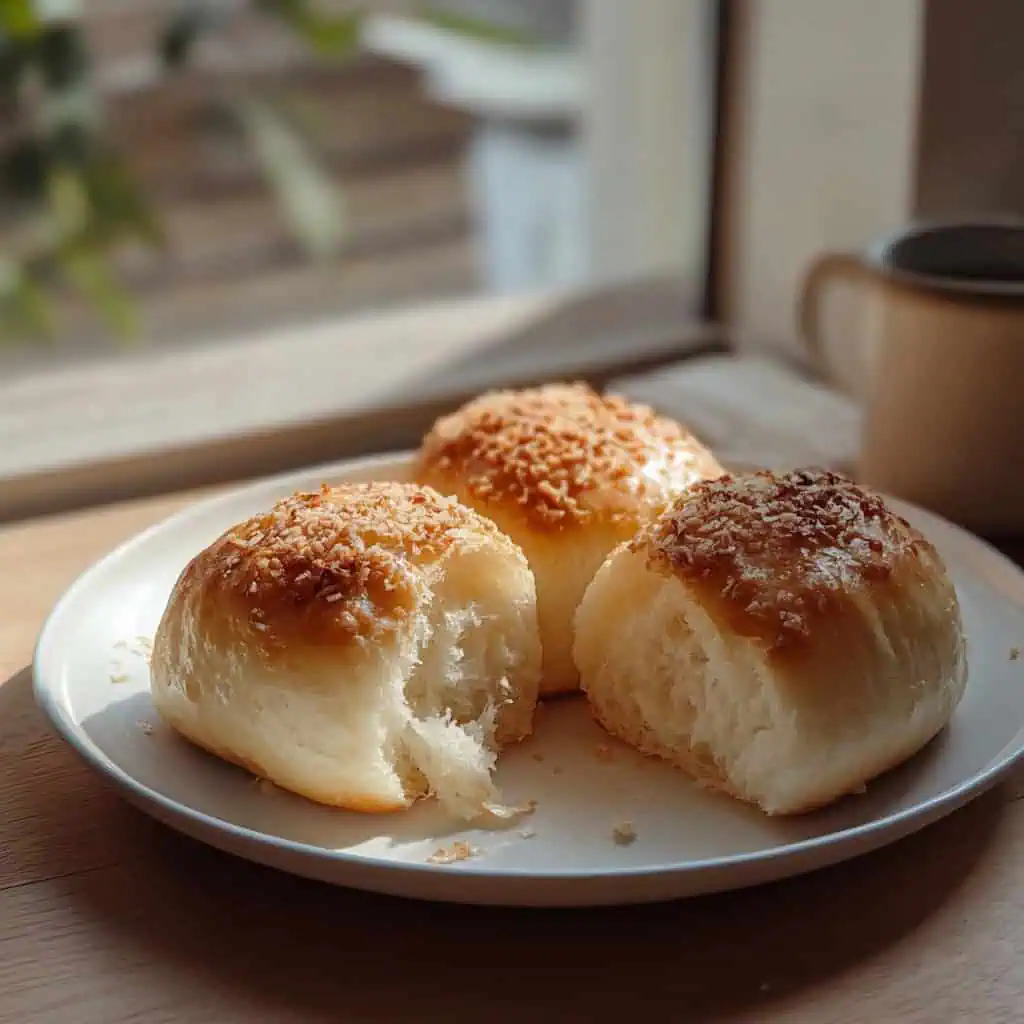

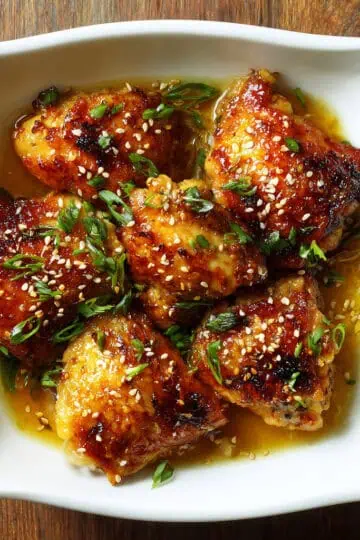




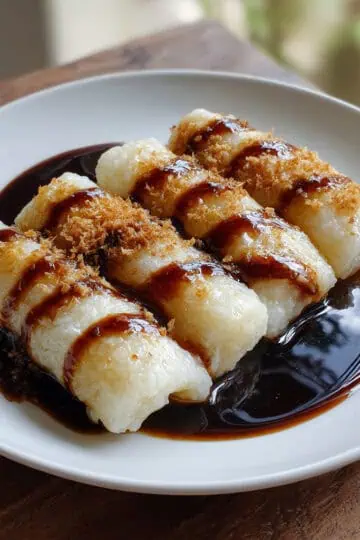
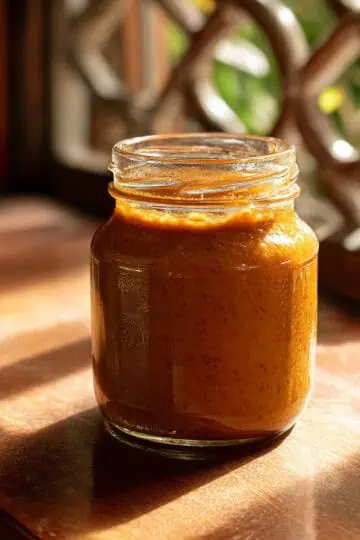

Comments
No Comments